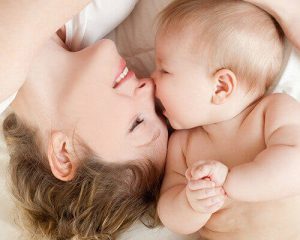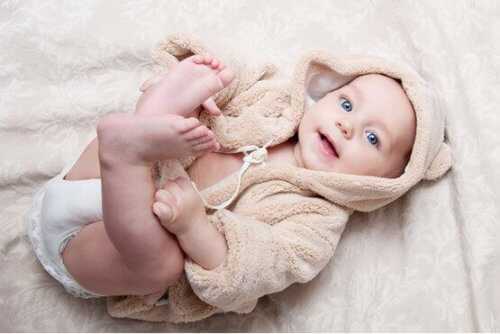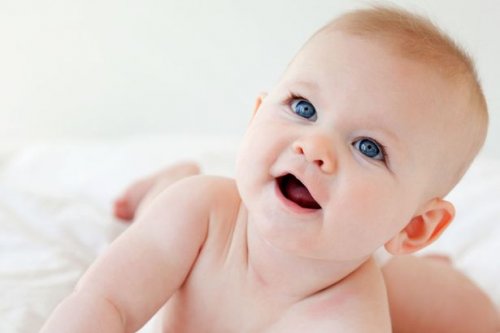The Second Month of Your Baby's Life

These exciting changes produce great enthusiasm among parents as they can see their child developing. Your little one makes his first sounds, and will notice voices and noises around him.
You’ll notice that your baby is much more attentive to what’s happening around him. However, he’s still unable to identify the sources of sounds and lights.
Characteristics of two-month-olds
At this stage in your child’s life, she’ll present the following characteristics:
- Your baby can hold up her own head for a certain amount of time.
- At two months, babies can move their eyes and head to accompany the movements of someone or something.
- You’ll see your baby’s first smile. And it will be the first of many! Don’t forget to take pictures!
- Though your child is able to move her extremities, she has yet to gain enough coordination to grab onto objects.
- If possible, your breast milk should be your baby’s only source of nourishment. That is, unless circumstances dictate that you must give your baby formula.
- Your child’s BM rhythm will change somewhat. She may go up to 5 days without soiling a diaper, and there’s no need to worry. This is due to the fact that the mother’s milk hardly produces any waste to eliminate. However, if your child drinks formula, she’ll probably soil her diapers more often.

Changes to your baby’s body during the second month of life
As for nourishment, during the second month of life, babies drink an average of 5–6 times per day, and drink 5–6 ounces each time.
There are several factors that influence weight and size. These include weight and size at birth, sex, and how far along your pregnancy was when your baby was born.
However, most babies average between 8 lbs 13 oz and 14 lbs 5 oz. As for height, babies this age vary between 21 and 24 inches, approximately.
In regards to your baby’s motricity, he’ll incorporate new movements as he acquires muscle strength and coordination. Your little one is just learning to control his body.
If you lay him face down, he might be able to raise his head slightly with the support of his arms. He may also keep his head straight if you pull his arms, sitting him up from a back-lying position.
Given that a baby’s vision begins to improve at this point, a child can recognize his parents. This might make him smile from time to time.
At the same time, he’ll react when he sees his mother’s breast or his feeding bottle. And speaking of feeding, you’ll notice your child’s improved suckling abilities after several weeks of experience. Feedings will become shorter and more efficient.
Remember: When speaking about the development of babies, each baby will progress at his own rhythm and growth capacity.
“Given that a baby’s vision begins to improve at this point, a child can recognize his parents”
Child-raising tips for parenting your baby at two months of age
- You must always pay attention to and follow your child’s vaccine calendar. Your little one’s immune system is still very vulnerable, and these dosis will help keep her out of danger. Remember that your child might present a slight fever in the hours following a vaccine shot.
- Always be vigilant. You should always keep an eye on your baby, even when you lay her down in bed or on her changer. Babies can be very restless and, even though they can’t sit up yet, they can roll and scoot about while lying down. Be very careful to avoid any accidents.
- As for hygiene, it’s important to change your baby’s diaper often to avoid any irritation in the diaper region. It’s best to clean your baby with a damp cloth. Most babies at this age enjoy bath time. You can take advantage of this fact and bathe your little one every 1-2 days. However, experts have conflicting opinions regarding the frequent bathing of babies.

Stimulation at 2 months of life
The second month of your baby’s life is fertile grounds for stimulation. This is because your child is more and more in contact with his surroundings and relates more with other people.
Taking advantage of the time your baby is awake is fundamental. Speak to him, snuggle with him, and show him the world around him. Let your child touch you and explore your body and his own.
When you lay your baby down, place him face up with some object hanging above. This will help your little one identify the object, focus his vision, and recognize colors, sounds and movements.
You can also take your baby out for a walk, as your little one is discovering the outside world. Help him to do so!
All cited sources were thoroughly reviewed by our team to ensure their quality, reliability, currency, and validity. The bibliography of this article was considered reliable and of academic or scientific accuracy.
- Sabater, V. (2019, 19 mayo). Un niño feliz es ruidoso, inquieto, alegre y revoltoso. Recuperado de https://mejorconsalud.as.com/nino-feliz-ruidoso-alegre-revoltoso/
- Liliana, S. (2012). Estimulación temprana. Guía de actividades para niños de hasta 2 años. Ediciones Lea.
This text is provided for informational purposes only and does not replace consultation with a professional. If in doubt, consult your specialist.
